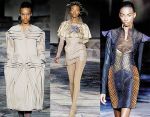(Part three of a four-part series)
It’s a mystery why some guests at New York fashion week could not wrap their minds around the idea of a prime-time show at the main venue featuring designers from Africa.
A mystery, that is, until one considers that many Americans perceive the continent as a scattered collection of mud huts, shanty towns, poverty and war to the exclusion of bustling major cities with towers, skylines and rich cultures that date back to the dawn of civilization.
 |
|
BLACK COFFEE, LOIN CLOTH & ASHES, DEOLA SAGOE
|
So although the primary intent was probably not to enlighten an ignorant, miseducated public, doing just that was an accomplishment of organizers of the Arise Magazine African Collective fashion show.
The runway presentation at the Bryant Park tents during Mercedes-Benz Fashion Week marked the third time the event has been staged. It has experienced greater attendance each time, from February 2009 to September 2009 to capacity attendance at the largest tent space at Bryant Park Feb. 13.
New York Fashion Week has been the site of many international designer collectives in the last decade, from India, Asia and Canada to Russia and Argentina. But few have been as well attended—and none as consecutively long-running—as Arise.
The global platform afforded by extensive media coverage of New York Fashion Week is worth its weight in gold to those who can afford to pay the price. That number now includes Arise, a monthly magazine dedicated to celebrating African style and culture. The oversize, glossy publication is sold in 150 countries around the world.
The fashion show is presented by This Day, a Nigeria-based global newspaper that publishes Arise and maintains a bureau in Washington, D.C.
“We are proud that we can give some incredibly talented designers an opportunity to showcase their creations on a global platform, one they would not previously have been afforded,” said Nduka Obaigbena, chairman and CEO of This Day.
The publication chose three labels to show their fall 2010 collections: Deola Sagoe, Loin Cloth & Ashes and Black Coffee. Though distinctly different, together they exhibited a fashion-forward feel more akin to European designers than American ones. Stronger silhouettes with more dramatic volume and proportion made their garments look more like wearable works of art as the rule rather than the exception.
The collections, all womenswear, were on trend with the direction in fashion now. There was less subtlety than Americans are accustomed to and more energy and punch.
DEOLA SAGOE
Sagoe, of Nigeria, showed looks characterized by tapered trousers, short-hemmed dresses, slashed and frayed fabrics and jackets with bold shoulders in a color palette heavy on browns, rusted oranges and midnight blues with beaded embellishments and the rich glimmer of gold. Dubbed “Above the Fray,” the line was inspired by 18th century European military uniforms and East African Maasai warriors.
Sagoe, who began designing in 1998, has won several design awards, including the MNET/Anglo Gold African Designs 2000 Award, for which she was nominated by Vogue’s U.S. editor-at-large Andre Leon Talley. She also exhibits her couture collection at Cape Town Fashion Week in South Africa.
LOIN CLOTH & ASHES
Tanzanian designer Anisa Mpungwe sent out younger styles painted predominantly in blacks and grays. With the near-monochromatic color palette, her feminine, softly structured shapes came to the forefront. An intriguing origami bird motif gave the collection a whimsical touch of whimsy.
Mpungwe launched the label in 2008, the same year she won the Young Designer of the Year award in the Elle New Talent Competition. She has trained at the Midland Graduate Institute, taken a course in creative pattern construction at the London College of Fashion, and presented her line at fashion weeks in South Africa, Mozambique and Sweden.
BLACK COFFEE
Overcoats are the hallmark of autumn and winter dressing, and design duo Jacques van der Watt and Danica Lepen rendered theirs on a deluxe scale in muted tones. Quilted and padded wool and leather gave the coats larger-than-life volume and structure, their construction inspired by the geometry of African masks and their influence on cubism king Pablo Picasso.
The attention-grabbing coats were worn over simple dresses, though one could easily imagine them with suits and wide-leg trousers. More about the careful cut and manipulation of fabric rather than bling and add-on embellishment, they were fabulous fabric cocoons into which a woman could easily and comfortably slip.
The label has won various design awards, including a South Africa Fashion Award twice and last year’s Mercedes Benz Award for Fashion, which included a show at Berlin Fashion Week. The 10-year-old brand also has shown at fashion weeks in South Africa and San Francisco and is sold at several stores in South Africa.
The inclusion of Black Coffee is the first time Arise has featured a collection by White designers. It was a sign that that the rising new South Africa in particular and the emergence of Africa in general will be characterized by a new multiculturalism.